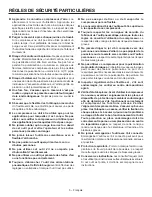
12 – English
OPERATION
Control the amount of air flow with the pressure regulator
knob. Turning the knob fully counterclockwise will
completely stop the flow of air.
NOTE:
Always use the minimum amount of pressure
necessary for your application. Using a higher pressure
than needed will drain air from the tank more rapidly and
cause the unit to cycle on more frequently.
When finished, always stop the engine and drain the tank.
Never leave the unit running unattended.
DRAINING THE AIR TANK
See Figures 17 - 18, page 21.
To help prevent tank corrosion and keep moisture out of the
air used, the air tank of the compressor should be drained
daily.
To drain:
Turn off the air compressor.
Pull the ring on the pressure relief valve to release air
pressure. Continue venting until pressure gauge reads
less than 20 psi.
Release the ring.
Rotate drain valve counterclockwise to open.
Tilt tank to drain moisture from tank into a suitable
container.
NOTE:
This tool is heavy. To avoid back injury, lift with
your legs, not your back, and get help when needed.
NOTE:
Condensate is a polluting material and should be
disposed of in compliance with local regulations.
If drain valves are clogged, release all air pressure, remove
and clean valves, then reinstall.
WARNING:
Turn off the air compressor and release all air from
the tank before servicing. Failure to depressurize
tank before attempting to remove valve may cause
serious personal injury.
Rotate drain valve clockwise until tightly closed.
MOVING THE AIR COMPRESSOR
Turn the air compressor off.
Tilt the machine away from you until it balances on the
wheel then roll the machine to the desired position.
Allow 30 minutes of “cool down” time before storing the
machine.













































